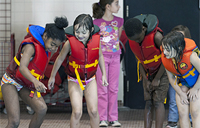A program offered at York University is saving the lives of children and young people in the Jane and Finch, and Black Creek communities. Offered by York University’s Sport & Recreation at the Tait McKenzie Centre pool, it is teaching children how to survive should they fall into deep water.
 Children taking part in the Swim to Survive program at York University learn essential skills in drown proofing in a fun and meaningful way
Children taking part in the Swim to Survive program at York University learn essential skills in drown proofing in a fun and meaningful way
Funded for two years by the Academic Innovation Fund (AIF) at York University, the Swim to Survive program is now entering its second year. A new series of lessons, which began Jan. 12, are bringing children, youth and their parents to York’s Keele campus to participate in the free program that includes a series of instructional drown-prevention sessions taught by Certified Lifesaving Society Swim Instructors. The goal of the program is to teach participants how to not panic should they fall into water and provide them with the basic skills needed to survive in the water.
“A lot of newcomers to Canada believe that staying away from water is the best way to prevent drowning, but actually being able to survive in the water and get out and find your way to the shore is the best way to prevent drowning,” explains Stephanie Vuilleumier, client service representative and the aquatic supervisor at the Tait McKenzie Centre.
According to statistics kept by the Lifesaving Society’s Who’s Drowning initiative, there were 34 deaths by drowning between Jan. 1 and June 17, 2012, a 13 per cent increase from the same period in 2011. Many of the tragedies happened in lakes and swimming pools.
“Most drowning happens in lakes or unguarded backyard pools,” says Vuilleumier. “It is often non-swimmers or weak swimmers who fall victim to drowning.”
The Swim to Survive program, developed by the Lifesaving Society, is part of a national initiative to prevent drowning . The program is offered to children in Grade 3 at many Ontario schools.
The program offered at York University is unique because it is part of a research study to assess the swimming ability of participants at the beginning, midpoint and conclusion of the eight week session. The purpose of the study is two-fold. The first objective is to track community engagement in the program and the second is to obtain evidence-based research for a drowning prevention strategy that combines practical water safety skills and up-to-date water safety information. The data collected from the tracking study will be used to further drowning prevention efforts in the community and the province.
The most important and basic skill that participants learn, says Vuilleumier, what to expect when they fall into deep water. “This involves teaching them how to roll into the water because it is very similar to the experience of falling in, when you become disorientated about what is up and what is down.”
Participants are then taught how to surface and tread water for one minute, or more if possible. “Treading water is important because it teaches you how to keep your head above water so that you can see where you are and where the shoreline is,” says Vuilleumier. “Participants also learn how to swim 25 metres because the most common distance where people drown is 20 metres or less from the shore.”
York’s program is delivered to children aged six years and up. “We have two groups that include children from the community and their parents (if they wish to participate) and if we have enough space, we take all of the parents,” she said.
The program encourages children and their parents to enter the pool fully clothed and teaches participants to roll, surface, tread water and swim with their clothes on. It is not meant as a replacement for standard swimming lessons, however, the program is an important first step to being safe around water and could make the difference between life and death when immersion in water is sudden and unexpected.
“Last fall, the Swim to Survive staff taught two teenagers who were friends of a local youth who had drowned while at summer camp,” recalls Vuilleumier. “They were very traumatized by the death of their friend and wanted to learn how to swim.”
Vuilleumier is working on developing a self-sustaining model to continue the program. Noah Wayne, a fourth-year PhD student in the School of Kinesiology & Health Science in the Faculty of Health, will be assessing the data on the program for an academic paper.
For more information about the Swim to Survive program, contact Vuilleumier by e-mail at svuill@yorku.ca.


